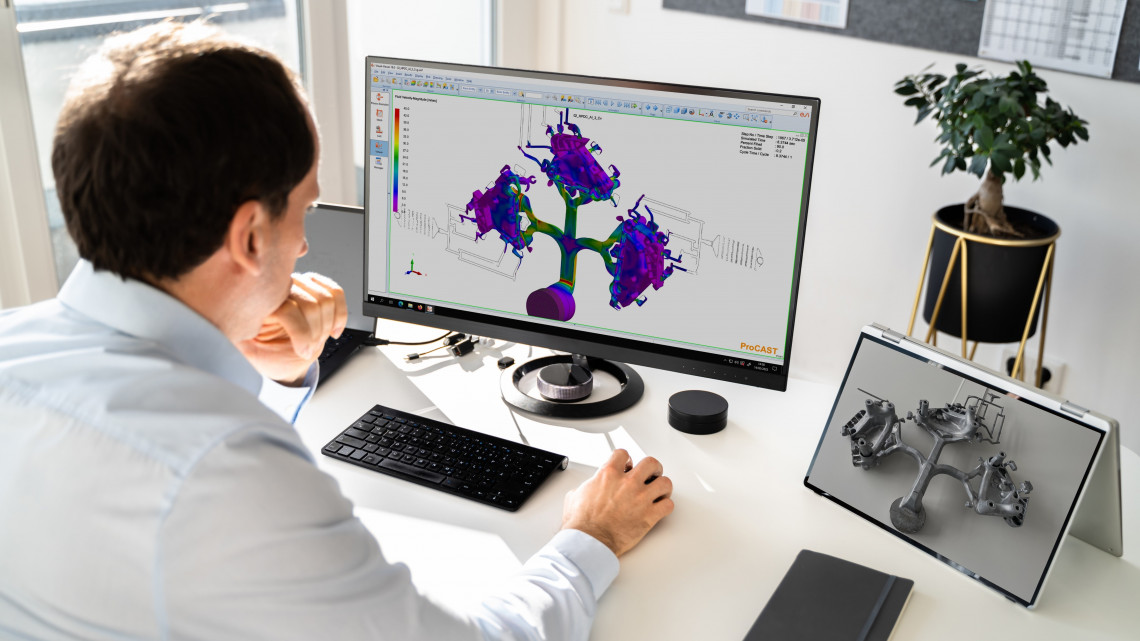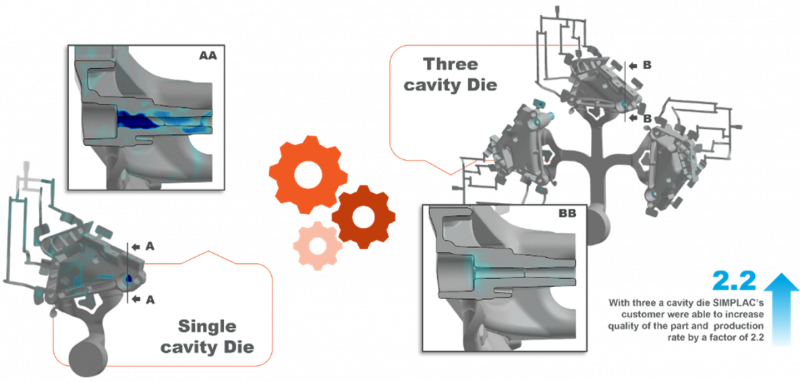SIMPLAC doubles the production rate of a VW part with ESI’s die casting simulation software
Virtual prototyping with ProCAST secures customer satisfaction for mold makers

Thanks to ProCAST, SIMPLAC helps VW part supplier to increase its production rate by a factor of 2.2 and reduced scrap rate. Engineers were able to simulate the complete Die Casting process including DCM selection. These benefits demonstrate why virtual test and prototypes are mission-critical to innovation and lightweight parts.
New challenges for mold makers in the automotive industry
Tier 1 suppliers are a vital part of the supply chain for every industry, as OEMs depend on them to create high-quality parts in a short timeframe. Therefore, the challenges that OEMs face inevitably become the challenges of their suppliers – and vice versa. In today’s transformative world, almost every manufacturer is looking for ways to support a more sustainable future by working towards cleaner, safer, and more performant products and processes.
For automotive suppliers, specifically, mold and tool manufacturers like SIMPLAC, the challenge to produce lightweight parts has an especially important impact on them as their molds and tools are produced for aluminum and magnesium alloy High-Pressure Die Cast parts. Additionally, when any of SIMPLAC’s customers increases its demands, SIMPLAC is keenly aware that it will need to make a major shift in its process, from feasibility to validation, preserving its place as an integral part of the automotive value chain.
SIMPLAC doubles down on casting simulation software
SIMPLAC is a known and trusted supplier in the automotive industry as they began specializing in die casting mold design and production more than 30 years ago. But it wasn’t until the early 2010s that they started to push for an even higher level of accuracy and competitiveness in their engineering process and production. At this point, they had a pulse on how the industry was shifting due to the increasing demand for complex parts and, as they had done many times before, they anticipated their customers’ challenges and how they needed to pivot to continue adding value to their partnerships. That is the moment they realized they needed to make a quantitative leap in their simulation capabilities.
SIMPLAC has relied on ESI’s simulation and virtual prototyping software, services, and support for almost a decade. The advanced capabilities offered by ProCAST casting simulation software like advanced flow model, air entrainment, or thermomechanical analysis, help SIMPLAC virtually simulate their mold during the high-pressure casting process and support them during all decision-making phases for all types of projects – none too big or too small.
Improved quality and increased productivity with casting simulation
One specific use case SIMPLAC shared is how casting simulation helped them double the production rate for one of their customer’s parts. Let’s delve deeper into some of the main challenges that led to this advantageous outcome. Like with most things, the high-pressure die casting mold VW uses to manufacture an aluminum engine mount will eventually come to the end of its life cycle. Additionally, some quality problems were identified during production connected to the casting process, mainly related to air entrainment, ultimately leading to an increased scrap rate.
Naturally, VW part supplier turned to their mold maker to help solve its challenges. How could SIMPLAC ultimately improve the quality of the engine mount and increase productivity?
SIMPLAC proposed moving from a single-cavity die to a three-cavity die, which came with its own set of challenges:
- Larger mold size
- New and more complex gating system
- Redefining the cooling system
- Selecting a new die casting machine
- Avoiding part distortions
With the ability to solve major challenges like these, SIMPLAC knew it would not only strengthen relations with an existing customer but would also foster new relationships with other automotive OEMs.
A casting process to build a reliable virtual prototype
Using ProCAST, SIMPLAC’s engineers quickly identified and anticipated the main issues related to filling and solidification during the feasibility stages in the early phases of the project. We were able to properly define and design a gating system that met the quality requirements VW required.
Luís MachadoDie Casting Dies General Manager/Co-owner
Once the mold cavity was designed, SIMPLAC used ProCAST’s advanced capabilities to build the rest of the mold while:
- Ensuring uniform solidification by validating the entire cooling system with CFD calculation in the cooling channels with the help of the Cooling channel module
- Avoiding critical shrinkage porosity defects
- Reducing cycle times to a minimum
- Ensuring dimensional tolerances of each part with thermomechanical simulation
During various validation phases of the mold, all the different steps of the casting process were modeled to build a reliable virtual prototype including dosing, shot sleeve, solidification, mold opening, and part ejection.
Eventually, they were victorious in advancing from a single-die cavity design to a triple cavity die design. Because of this, VW’s direct part supplier increased its production rate by a factor of 2.2, improved part quality and reduced scrap rate, directly contributing to their sustainability goals. It also helped to improve operating margins as they were able to select an optimal 1200T DCM. This was possible because ProCAST allows users to virtually consider the machine’s technical specifications.
All these benefits demonstrate how relying on virtual tests and prototypes, limiting the physical ones is mission-critical to innovate new lightweight parts and having more sustainable engineering and manufacturing processes. For SIMPLAC specifically, the benefit of building and strengthening their relationship with OEMs worldwide is immeasurable.
Get in touch with ESI’s casting experts
To discover how virtual prototyping can support you throughout your products' development and manufacturing phase, watch our recent webinar, “Simulate the complete casting process to reduce defects”, On-Demand!
Beyond this, my UK colleague Ronan Cronin will present this story at the upcoming CASTcon 2023 event. Book a meeting upfront to learn how your organization can replicate this success.
Igor is a Mechanical and Materials Engineer with more than 17 years of experience in Virtual Manufacturing specifically, Casting, Welding, Heat Treatments, and Plastic Injection Molding. He is currently part of the EMEA Casting Customer Experience team at ESI Group and has been working as Pre and Post Sales Technical since 2008. Igor is hands-on with customers as he handles the implementation, training, and support for ProCAST and QuikCAST users. He believes in the partnership with customers, a core ESI value.
